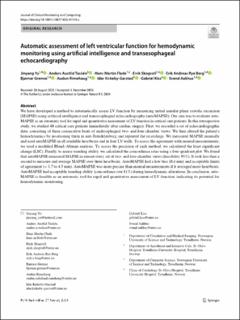| dc.contributor.author | Yu, Jinyang | |
| dc.contributor.author | Tasken, Anders Austlid | |
| dc.contributor.author | Flade, Hans Martin | |
| dc.contributor.author | Skogvoll, Eirik | |
| dc.contributor.author | Berg, Erik Andreas Rye | |
| dc.contributor.author | Grenne, Bjørnar Leangen | |
| dc.contributor.author | Rimehaug, Audun Eskeland | |
| dc.contributor.author | Kirkeby-Garstad, Idar | |
| dc.contributor.author | Aakhus, Svend | |
| dc.date.accessioned | 2024-04-08T13:45:35Z | |
| dc.date.available | 2024-04-08T13:45:35Z | |
| dc.date.created | 2024-01-27T21:00:41Z | |
| dc.date.issued | 2024 | |
| dc.identifier.issn | 1387-1307 | |
| dc.identifier.uri | https://hdl.handle.net/11250/3125353 | |
| dc.description.abstract | We have developed a method to automatically assess LV function by measuring mitral annular plane systolic excursion (MAPSE) using artificial intelligence and transesophageal echocardiography (autoMAPSE). Our aim was to evaluate autoMAPSE as an automatic tool for rapid and quantitative assessment of LV function in critical care patients. In this retrospective study, we studied 40 critical care patients immediately after cardiac surgery. First, we recorded a set of echocardiographic data, consisting of three consecutive beats of midesophageal two- and four-chamber views. We then altered the patient’s hemodynamics by positioning them in anti-Trendelenburg and repeated the recordings. We measured MAPSE manually and used autoMAPSE in all available heartbeats and in four LV walls. To assess the agreement with manual measurements, we used a modified Bland–Altman analysis. To assess the precision of each method, we calculated the least significant change (LSC). Finally, to assess trending ability, we calculated the concordance rates using a four-quadrant plot. We found that autoMAPSE measured MAPSE in almost every set of two- and four-chamber views (feasibility 95%). It took less than a second to measure and average MAPSE over three heartbeats. AutoMAPSE had a low bias (0.4 mm) and acceptable limits of agreement (− 3.7 to 4.5 mm). AutoMAPSE was more precise than manual measurements if it averaged more heartbeats. AutoMAPSE had acceptable trending ability (concordance rate 81%) during hemodynamic alterations. In conclusion, autoMAPSE is feasible as an automatic tool for rapid and quantitative assessment of LV function, indicating its potential for hemodynamic monitoring. | en_US |
| dc.language.iso | eng | en_US |
| dc.publisher | Springer | en_US |
| dc.title | Automatic assessment of left ventricular function for hemodynamic monitoring using artificial intelligence and transesophageal echocardiography | en_US |
| dc.title.alternative | Automatic assessment of left ventricular function for hemodynamic monitoring using artificial intelligence and transesophageal echocardiography | en_US |
| dc.type | Peer reviewed | en_US |
| dc.type | Journal article | en_US |
| dc.description.version | publishedVersion | en_US |
| dc.rights.holder | © The Author(s), under exclusive licence to Springer Nature B.V. 2024 | en_US |
| dc.source.journal | Journal of clinical monitoring and computing | en_US |
| dc.identifier.doi | 10.1007/s10877-023-01118-x | |
| dc.identifier.cristin | 2235994 | |
| cristin.ispublished | true | |
| cristin.fulltext | original | |
| cristin.qualitycode | 1 | |
